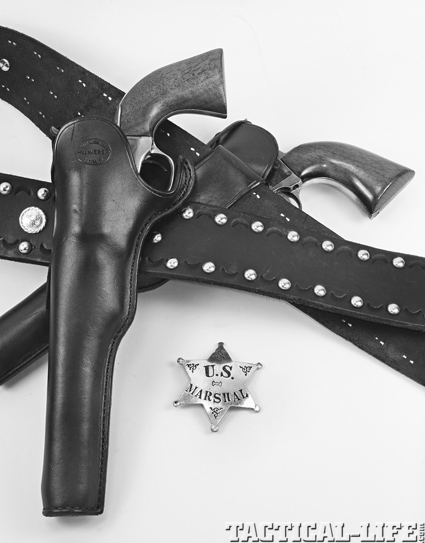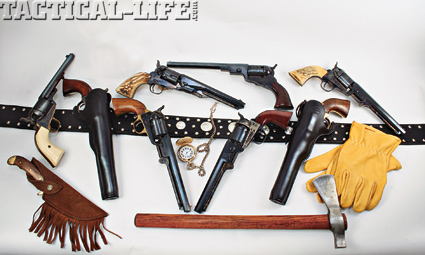Over the course of my life I’ve been told by a couple of women that I have commitment issues. I disagree. In the right relationship, I can go the distance. I’ve carried on a 37-year love affair with Colt’s 1851 Navy revolver. If that isn’t commitment, I don’t know what is.
Falling in love with the Colt Navy was easy for me. That pistol has “supermodel” good looks with its long, sleek octagon barrel, color casehardened receiver and gorgeously proportioned grips. But good looks alone wouldn’t be enough to sustain a serious relationship into its fourth decade. I love the Navy because it performs as well as it looks. And it also has a captivating past I love to learn about.
My First Love
The first handgun I ever owned was a brass-framed replica of an 1851 Navy revolver. It was a Christmas present from a girlfriend in 1972. It cost her $36, and it was one of the best presents I ever received. Throughout my college years I shot thousands of rounds through that pistol. Most of them were maximum loads, and that brass frame just wasn’t up to the challenge. It stretched something wicked. By the time I retired that Navy, the barrel cylinder gap was over a sixteenth of an inch wide. In fact, there was so much fore and aft play in the cylinder that, after I cocked the hammer, I’d have to pull the cylinder backwards so the bolt could engage the slot to lock it up for firing.
Advertisement — Continue Reading Below
I know that sounds pretty bad, but I’ll tell you the truth; I loved that gun. It fit me like it grew out of my hand. The balance was superb. And it was my first pistol and that’s something not easy to forget. And because of that, since I was 17 years old, I’ve always had at least one 1851 Navy in the gun cabinet. But ruining that first Navy did teach me one lesson. I’ve never owned another brass-framed sixgun.

In the 19th century, no Navy revolvers were chambered for .44 caliber, but the author really likes reproduction Navies in that chambering. The bottom .44 Navy was made by the now-defunct firm of Armi San Marcos in the mid-1990s ordered from EMF. The top revolver was made by Pietta, but fitted with an Armi San Marcos grip assembly so both guns would feel and handle the same.
Advertisement — Continue Reading Below
EMF Navies
For almost 10 years I shot a beautiful pair of steel-framed Navy replicas imported by EMF from the now defunct Italian firm of Armi San Marcos. I always thought the Armi San Marcos Navies had the most authentic geometry of any of the replicas. And those particular EMF Navies were about the best cap-and-ball sixguns I ever owned. But in the late 1990s the cartridge conversion bug bit me hard, and I had that pair of Navies converted to fire .38 Special cartridges.
I never regretted that decision. My Navy conversions are among my most prized possessions, but if I’d been really smart, I would have bought two more Armi San Marcos Navies from EMF while they were still being manufactured. That way I could have had two converted to cartridges, and still have kept two of them in cap-and-ball configuration.
I do still have one Armi San Marcos-made Navy in cap-and-ball mode, but that one is in .44 caliber. Production runs of original Colt Navies were only made in .36 caliber, though I understand some prototypes were made in .40 caliber. So that makes my .44 caliber Navy an abomination to historical purists. While I can be a bit of a period-correct fanatic myself, I can’t help loving that .44 caliber Navy. It combines the great looks and outstanding balance of the 1851 Navy with the hard-hitting power of an 1860 Army revolver. In my view Sam Colt should have chambered the 1851 in .44 caliber. He’d have had a winner in the marketplace.
Advertisement — Continue Reading Below

These are Beliveau’s .36 caliber cap-and-ball 1851 Navies. The brass grip-framed specimen at the top came from DGW in 1982. The London Model, with its blued steel grip frame was ordered from Taylor in 2008.
Pietta Navy
I like my Armi San Marcos .44 caliber Navy so much that a few years ago I picked up a newly manufactured .44 Pietta Navy from MidwayUSA. Pietta built the new .44 and it is a good looking, solid sixgun but it suffered from the Pietta Navy grip, which has a very odd ergonomic shape. I solved that with five minutes of work with a screwdriver. I simply swapped out the Pietta grip assembly for an Old Armi San Marcos grip frame that I had in the parts bin. The result is a pair of hard-hitting .44s that feel and handle the same.
Advertisement — Continue Reading Below
I love my .44 Navies, but I just wouldn’t feel right if I didn’t have a set of Navies chambered for the period-correct .36 caliber. Even though I had sent my Armi San Marco Navies off to be converted, I still had a .36 Navy in the gun cabinet. Back in 1982, I had sent to Dixie Gun Works for one of their house brand 1851 Navy revolvers. Though it proudly says “Dixie Gun Works-Tennessee” on the top barrel flat, the small “DGG” stamp under the barrel tells me that Armi San Paolo, now known as Euroarms in Concesio, Italy, built this revolver.
They no longer export Colt replicas to the States, but back in the day, they made an attractive, solid 1851 Navy. I’ve been shooting this one for 25 years and it still looks good and shoots straight. My only gripe about it is that the grips are thicker than I like. But it hasn’t bothered me enough to slim them down over the 25 years that I’ve been shooting this pistol.
DGW Navy
During all those years the belt mate to that Dixie Gun Works .36 caliber 1851 Navy was an even older gun. I purchased this .36 caliber cap-and-ball revolver in 1980. Like the Dixie Navy, Armi San Paolo also built that gun, but it isn’t an 1851. Instead, it is the more streamlined 1861 Navy. This was Sam Colt’s attempt to translate the flowing lines of the then new Colt 1860 Army revolver into a .36 caliber configuration. Unfortunately for Colt, the ’61 Navy flopped in the marketplace. Shooters continued to buy the 1851 Navy in much larger numbers right up until Colt discontinued cap-and-ball production in 1873.
Advertisement — Continue Reading Below
Years ago I mounted a set of Eagle stag grips on the 1861 Navy and for a while it was my most heavily used cap-and-ball sixgun. But after 27 years of black powder shooting it is showing its age. Just recently I convinced myself that I needed to give the 1861 a rest and pick up a new 1851 Navy to team up with my old Dixie gun. I don’t know about you, but I never fail to amaze myself at the lengths I’ll go to in order to rationalize purchasing a new gun.
Uberti Navy
I decided this new Navy would be manufactured by Uberti. I’ve had a longstanding issues with Uberti because I really don’t like the brass grip shape on their standard 1851 Navy replicas. But a few years ago I picked up one of their London model 1851s. Instead of the typical brass grip frame, the London model has a steel grip assembly that is interchangeable with their Model P cartridge-firing, Single Action Army (SAA) clones. That Model P grip frame is a vast improvement.

Advertisement — Continue Reading Below
The slight step in the cylinder to accommodate the larger diameter balls is the only visual difference between 1851 Navy revolvers chambered for .44 caliber versus those historically correct specimens chambered in .36 caliber.
I really liked the London model Navy, but I sent it off almost immediately to be converted to .38 Long Colt by conversion wizard Kenny Howell. I wanted to recreate the type of pistol carried by Keith Carradine where he portrayed Wild Bill Hickok in the HBO series, Deadwood.
Taylor’s London Navy
You may be noticing a bit of a pattern here. Whenever I get an 1851 Navy that I really like, it seems like I send it off to be converted to fire cartridges. But this time I had learned a lesson from my past mistakes. So I ordered another London Model ’51 Navy from Taylor’s & Company, and this one will be staying in cap-and-ball condition.

Author carries his Navies in a pair of El Paso Saddlery 1849 Californian, Slim Jim-style holsters.
Carry Rigs
No pistol is really complete without gun leather. After years of experimenting with different holster styles, I settled on the perfect rig for the 1851 Navy. I have a pair of El Paso Saddlery’s 1849 Californian holsters in basic black. This holster is an authentic, mid-19th century slim Jim-style design that conforms to the silhouette of the revolver.
The top is a deep “S” curve that rises high enough at the top of the curve to protect the caps. The toe has a sewn-in plug with a vent hole. I had my holsters made with a slight cant for a butt forward carry. I use a cavalry-style draw, also known as a twist draw for my 1851s. It tends to freak out Cowboy Action Shooting (CAS) range officers, but I love that draw. It is fast and safe if you know what you’re doing.
Shooting Impressions
These days when we think of combat handgunning, we think in terms of distances from 7 to 25 yards. But when the 1851 Navy was developed they were sighted in for 75 yards. There are people who doubt that you can effectively shoot a gun with such crude sights at that distance. But back in the early ‘70s when I started shooting Navy cap-and-ball revolvers, one of my favorite targets was an old 55-gallon drum. I’d sit on the rim of a big gravel pit and shoot at it down in the pit, over 100 yards away. I loved hearing those round balls go “bong” when they hit that empty drum. I didn’t miss much.
I recently put the London Navy to the Dave Tutt test. As most of you know, Wild Bill Hickok drilled Dave Tutt through the heart at 75 yards across the courthouse square in Springfield, Missouri, in 1865. To see how difficult that was I put up a target, paced off 75 yards, and proceeded to put five rounds, off-hand into that target that would have hit Dave from collarbone to sternum, if he’d been standing there.
Today we’d rate the 1851 as a pretty puny fighting arm. The standard load I use is 22 grains of 3Fg Goex black powder, pushing a 0.38 of an inch round ball that only weighs 76 grains to an average velocity of 817 feet per second (fps). In the cartridge world the nearest equivalent would be a .32ACP, which not many of us would choose as our primary self-defense round. But Dave Tutt probably wouldn’t agree with that. Maybe we could take a lesson from Hickok. Maybe it doesn’t matter how big the gun is. What matters is how well you can use it.
























